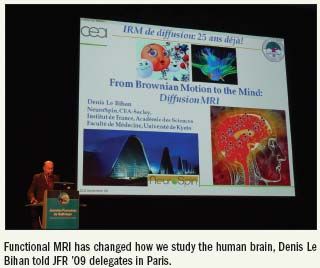French congress celebrates 25 years of diffusion MRI’s revolution inbrain anatomic and functional imaging
Diffusion MRI came under the microscope in Dr. Denis Le Bihan's plenary lecture at the French national congress, les Journées Françaises de Radiologie (JFR), held in Paris in October.
Diffusion MRI came under the microscope in Dr. Denis Le Bihan's plenary lecture at the French national congress, les Journées Françaises de Radiologie (JFR), held in Paris in October.
Le Bihan is the founding director NeuroSpin, an institute of the French Commissariat à l'Energie Atomique, which develops and uses ultrahighfield MR to understand the brain. Over the past quarter century he has helped to introduce into research and clinical practice the concept of diffusion MRI.
Diffusion MRI is used to study normal and diseased brain anatomy and function, as well as brain wiring, from the measurement of molecular motion, in particular water molecules, in biological tissues. The technique has been adopted by MR vendors, and is now widely used for both basic research and clinical applications, especially in acute brain ischemia, white matter diseases, and connectivity disorders.
As mentioned by other speakers during the congress, Le Bihan's work has paved the way for diffusion to be used outside the brain. Diffusion imaging of the body (ear, nose, and throat; chest; abdomen; and pelvis) should eventually become a very powerful tool that is not yet fully understood or utilized.
The development of functional MRI has changed the way we study the human brain, giving access to the neural networks underlying complex cognitive functions such as language, mental imagery, and even consciousness, according to Le Bihan. He added that water, an apparently simple substance, keeps a lot of secrets.
La Société Française de Radiologie (SFR), now with Prof. Jean-Pierre Pruvo as general secretary, used its annual congress to unveil a new look LA SOCIETE FRANCAISE DE RADIOLOGIE LAUNCHES NEW WEBSITE TO COINCIDE WITH CENTENARY French congress celebrates 25 years of diffusion MRI's revolution in brain anatomic and functional imaging for its website (www.sfrnet.org). To mark SFR's centenary in 2009, it has redesigned the site in an attempt to make it more functional and better suited to respond to the challenges of tomorrow.

One element of SFR's strategy is to reach out more to the general public and to promote better understanding of the relationship between patients and radiologists. The society is currently conducting an online survey about patients' experiences and perceptions of imaging examinations, and is urging patients to take part in a “grand public consultation.” Via the SFR website, where patients are invited to answer a series of multiple choice questions on topics such as the general conduct and availability of the radiologist, the anxiety caused by the examination, and acceptability of the waiting time for the results.
For the first time at JFR, members of the public could attend an open session about the real benefits of interventional radiology. The 60-minute session was held at lunchtime on Saturday Oct. 17 in the grand amphitheatre of the Palais des Congrès; the objective was to promote greater understanding and awareness of interventional radiology.
The three honorary members of JFR '09 were Dr. Fred Avni from Brussels, Dr. Ricardo Garcia Monaco from Buenos Aires, and Dr. Michel Lafortune from Montreal. Prof. Georges Charpak, who received the Nobel Prize in Physics in 1992 for his invention and development of particle detectors at CERN (European Organization for Nuclear Research), received the gold medal at JFR '09, while Profs. Jean-Michel Bruel, Francis Joffre, and Alain Roche were honorary medalists. Medals were presented by SFR president Prof. Philippe Devred.
Some delegates expressed surprise that no government officials attended JFR '09. French radiology still appears to be under attack, and a new wave of fee reductions has been announced. Another concern is that the training system is now producing more public healthcare specialists than radiologists (about 85 a year, compared with 70), yet clinical workloads continue to increase. Shifting imaging into the hands of other specialists is a real threat. The next JFR will take place from 22 to 26 October 2010 at the Palais des Congrès, Porte Maillot, Paris.
GE HealthCare Debuts AI-Powered Cardiac CT Device at ACC Conference
April 1st 2025Featuring enhanced low-dose image quality with motion-free images, the Revolution Vibe CT system reportedly facilitates improved diagnostic clarity for patients with conditions ranging from in-stent restenosis to atrial fibrillation.
The Reading Room Podcast: Current Perspectives on the Updated Appropriate Use Criteria for Brain PET
March 18th 2025In a new podcast, Satoshi Minoshima, M.D., Ph.D., and James Williams, Ph.D., share their insights on the recently updated appropriate use criteria for amyloid PET and tau PET in patients with mild cognitive impairment.